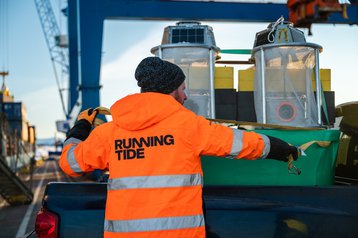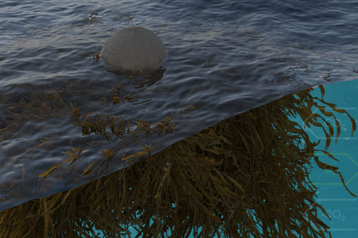Microsoft has paid to have 12,000 tons of carbon dioxide (CO2) removed into the open ocean over the next two years, by "ocean health" company Running Tide.
Running Tide offers carbon capture and removal by deploying floating buoys containing limestone, which boosts the ocean's alkalinity, and algae which then grows and captures more carbon, before sinking to the deep ocean, where gravity and water pressure hold the biomass. The captured carbon is trapped in a slow cycle that Running Tide says will keep it locked up for thousands of years.
Running Tide has told TechCrunch the deal is worth "single-digit millions", but Microsoft has so far declined to comment on the cost.
Running Tide's website says its technology "accelerates the ocean's ability to naturally remove carbon dioxide, sinking it to the deep ocean in a safe and permanent form". It has produced a White Paper detailing its approach, and has received backing from Stripe and Shopify, as well as Microsoft.
The company promises that its agreement with Microsoft will be validated through effective measurement, reporting, and verification.
The Intergovernmental Panel on Climate Change (IPCC) has said carbon removal is vital, and the human race needs to gear up to remove up to ten gigatons of carbon into permanent storage every year to avoid overshooting the critical 1.5 degrees Celsius warming mark. Ocean-based carbon removal has been cited as an important strategy by The US National Academy of Sciences, and the IPCC.
Microsoft has committed to being carbon negative by 2030, but recent announcements have shown this is a tough goal. The company's 2021 sustainability report revealed that the company's Scope 3 emissions (those caused in its supply chain) were increasing, due to a boom in data center building and high sales of its games hardware.
Scope 3 supply chain emissions are a major part of the footprint of virtually every company and, for Microsoft, supply chain emissions make up more than 98 percent of its footprint. The company stated in its sustainability report that it can only achieve net-zero for all its emissions if it matches these emissions with carbon removal.
Almost every form of carbon removal is still at an early stage of development, and is currently very expensive. Direct removal from the air can be done, for instance by Climeworks, however, this approach is very expensive (currently around $1000 per ton of carbon, though this is expected to fall) and also requires electricity, so it is only viable to do it where there is a large surplus of renewable power.
Ocean-based carbon removal is at a still-earlier stage of development, and Microsoft has promised to help the market establish verification and third-party certifications for it so that operations can be scaled up.
The approximate size of the Microsoft deal suggests a price lower than Climeworks' $1,000 per ton, and Microsoft says that the deal will include "gates" for each stage, which will unlock larger purchases when the technology is fully demonstrated, a process that the partners say will "help establish biomass-sinking as a viable and scalable carbon removal pathway".
"Supporting innovative solutions is part of Microsoft's carbon removal strategy," said Phillip Goodman, director of Microsoft's carbon removal portfolio. "Running Tide's dedication towards continued improvements in ocean-based MRV systems aligns with Microsoft's pursuit of innovative CDR projects, and we look forward to Running Tide's further development of the ocean-based carbon removal space."
Physically moving large numbers of seeded buoys to the open ocean requires ships, which require low energy, and thereafter the process uses gravity and ocean currents which require no further energy input.
Running Tide is also deploying a network of "satellite" buoys to monitor environmental data across the ocean.
"This agreement represents a joint investment in an abundant future: both in removing a significant amount of carbon while restoring ocean health for future generations," said Running Tide CEO Marty Odlin. "Our deal develops the system and technologies needed to responsibly steward our natural resources and to further our knowledge of and connectivity to the ocean."


